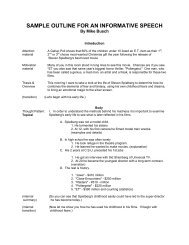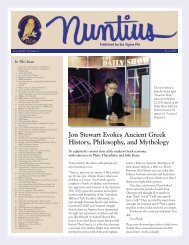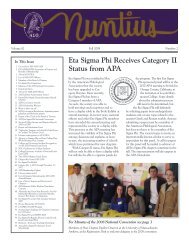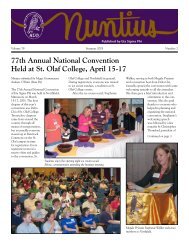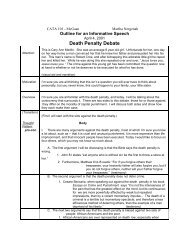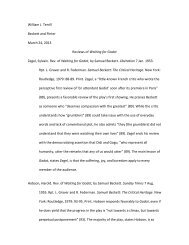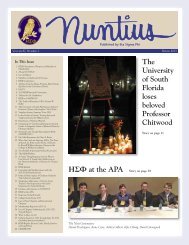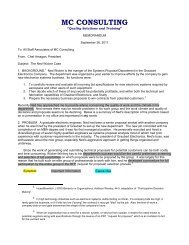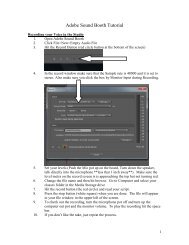In the Land of the Sibyl - Monmouth College
In the Land of the Sibyl - Monmouth College
In the Land of the Sibyl - Monmouth College
Create successful ePaper yourself
Turn your PDF publications into a flip-book with our unique Google optimized e-Paper software.
Uncovering History One Stratum at a Time<br />
by Rachel Cartwright<br />
ments. One overlooked <strong>the</strong> main street<br />
and <strong>the</strong> o<strong>the</strong>r <strong>the</strong> main plaza. The Atlantic<br />
Ocean was a five-minute walk down <strong>the</strong><br />
road, which kept <strong>the</strong> temperature in <strong>the</strong><br />
60 and 70-degree range. We worked from<br />
8 a.m. until approximately 2 p.m. on <strong>the</strong><br />
weekdays doing fieldwork and <strong>the</strong>n from 5<br />
p.m. to 6 p.m. in <strong>the</strong> lab. We took a bus to<br />
<strong>the</strong> site, which was very interesting when<br />
it went <strong>of</strong>f-roading up <strong>the</strong> hill where <strong>the</strong><br />
site was located. The bus would park near<br />
<strong>the</strong> bottom and we hiked halfway up to a<br />
shed where our equipment was stored. We<br />
would <strong>the</strong>n continue to <strong>the</strong> top <strong>of</strong> <strong>the</strong> hill<br />
to <strong>the</strong> actual site.<br />
For <strong>the</strong> first week and a half, I worked<br />
on surveying <strong>the</strong> site with a TDS (tripod<br />
data system) machine. I enjoyed doing <strong>the</strong><br />
This summer, thanks to Eta Sigma Phi’s<br />
Scholarship for Fieldwork in Classical<br />
Archaeology, I was able to discover history.<br />
I participated in <strong>the</strong> Iberian Archaeology<br />
Program: The Bagunte Project, which is<br />
located in Bagunte, Portugal. Dr. Mariah<br />
Wade led <strong>the</strong> project from The University<br />
<strong>of</strong> Texas at Austin. There were twelve students<br />
working at <strong>the</strong> site, myself included,<br />
and three supervisors. The site was <strong>of</strong> <strong>the</strong><br />
castro culture and <strong>the</strong> history <strong>of</strong> <strong>the</strong> site<br />
spanned from <strong>the</strong> Iron Age to <strong>the</strong> Roman<br />
era <strong>of</strong> habitation.<br />
We flew into <strong>the</strong> airport in Porto,<br />
Portugal and traveled to Vila do Conde<br />
where we stayed in two separate apartsurvey<br />
work, unless <strong>of</strong> course I had to hold<br />
<strong>the</strong> rod, which I found very difficult to hold<br />
still especially with <strong>the</strong> winds that blew<br />
on <strong>the</strong> top <strong>of</strong> <strong>the</strong> hill we were working on.<br />
My first trench was located halfway up <strong>the</strong><br />
hill. There is what is hoped to be a fallen<br />
fortification wall in <strong>the</strong> area surrounding<br />
<strong>the</strong> trench. The next trench was at <strong>the</strong> top<br />
<strong>of</strong> <strong>the</strong> hill where we found what we think<br />
was a house. The building contained pieces<br />
<strong>of</strong> slag, which we considered evidence<br />
<strong>of</strong> metallurgy in <strong>the</strong> house. There were<br />
two shards <strong>of</strong> glass found, a large number<br />
<strong>of</strong> pottery sherds, and two quern stones.<br />
Personally, I found an iron nail, a roman<br />
tile, and many pottery sherds. I drew<br />
several maps <strong>of</strong> our trenches both <strong>of</strong> <strong>the</strong><br />
walls, to show <strong>the</strong> stratigraphic layers, and<br />
The Church and Stairway at Bom Jesus<br />
10



